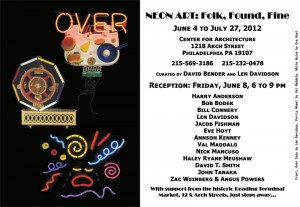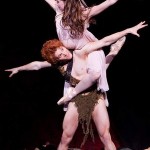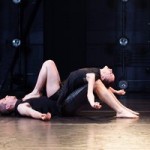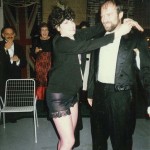BY: Merilyn Jackson 07.17.2012
 Tom Lux— aka the Wrecking Ball— plowed over my lines.
Tom Lux— aka the Wrecking Ball— plowed over my lines.
Suck in that iambic pentameter! Or:
Notes from summer poetry boot camp
I’ve written poetry since I was a kid— not much of it very good, but I wrote it as best I could. In the ‘70s I took poetry classes and attended readings with my professor. At the original Painted Bride on South Street one June night, I met AJ Sabatini reading his poetry.
Six weeks later I broke my husband’s heart (and my professor’s) by moving in with Sabatini. Together we read poetry by Plath, Stevens and Williams, and passages from Finnegans Wake, in varying cadences to each other as foreplay. We didn’t have a TV.
Almost everyone we knew then wrote, composed or choreographed— all language forms that demand attention, interpretation, parsing and translation.
There was Jack, Maralyn, Patience, Jett, Annson, Karen and Joseph. Steve Berg, who had just started the American Poetry Review, left his shoeprints on our wall one night during an impromptu party we threw after an APR-sponsored reading by Robert Bly. Bly left a more impersonal ring on our end table from his icy glass. Unlike the wall, the table— with its cloudy nimbus moon in full eclipse— has traveled with us throughout the years.
Veiled eroticism
Some time ago, I became a little bored with writing arts criticism and began “raiding” old poems for good lines that refreshed my dance writing. Soon I was writing more and more poetry— mostly what you’d call arch-romantic stuff filled with lightly veiled eroticism. I confess I am a tease.
This year I applied to three summer poetry-writing workshops and was accepted to all three. I chose Colgate and Sarah Lawrence, since both gave me some scholarship funding. I just got back, after working with Peter Balakian at Colgate and Tom Lux at Sarah Lawrence.
I have just one question: Why didn’t I do this 30 years ago?
Colgate’s campus in upstate New York is art-gallery print beautiful. The college sits on a hill that seems a 90-degree angle when you climb it in 90-degree heat. The town of Hamilton is a 15-minute walk from the foot of its slope. And that’s about it if you’re without wheels. If you’re there for only a week there’s enough to explore on foot.
Emboldened by drink
But you find little time for sightseeing at a writing workshop. Matt Leone, who has run Colgate’s summer writing program for ten years, wedges in more talks, readings and social gatherings than a day can hold. It’s all you can do to steal an hour or two for writing.
Most of the faculty are published authors— Balakian, J. Robert Lennon, Dana Spiotta and Bruce Smith— who grew up in Philadelphia and got my Philly Girl ’tude as if we were cousins. Participants chatted with them after their readings and talks. Among the pithiest readers were Lennon— whose book of flash fiction, Pieces for the Left Hand, I gobbled at the beach in one afternoon last week— and Smith, whose Devotions are still wending homeward via the mail.
They also comprised a generous audience for the student readings each afternoon and again late into the evenings, when drinks emboldened us. These readings ranged from drab to dazzling, ho-hum to outrageous. Best of all, I got my first opportunity to read my work to an audience.
Finding my voice
Some of my fellow workshoppers weren’t sure my poems read well on the page. But when I stood up and said, “I don’t need no stinkin’ podium” and plowed into the crowd, performing my poems, they got it. I had never read to an audience before, but the minute the floor didn’t open up and swallow me, I knew I owned it. I had a voice, a pretty good one; I just had to find better ways to translate its tonalities from the stage to the page.
The workshops with Balakian had a warm and fuzzy quality, tentative and blanketed in political correctness and politesse. Balakian has a delicious international sidekick in Ioanna Karatzaferi, the Greek-born and part-time Manhattanite author and translator of more than 50 books in Greek. I had the pleasure of riding the six-hour bus to New York with her on my way down to Sarah Lawrence. I learned as much in those six hours as I did in the previous six days.
Ioanna and I shared common past adventures in political activism: she for Greek democracy, I for a free Poland. Each of us understood that meant we were working for people to be free to fuck up or succeed— their choice. By the end of the bus ride I reached the conclusion— which I think Ioanna supported— that I should follow my heart as well as my intellect in my poetic choices. That is, I should let the poems find their audiences instead of changing them to please less passionate, less nuanced readers.
Confronting the ‘Wrecking Ball’
Sarah Lawrence, just north of New York City, is more like jumping out of the print into a live, micro-version of Philadelphia’s Chestnut Hill. Very tony. Its much less sprawling campus put our living quarters within a two-minute walk of the dining hall and most of our workshops and events.
Here on Sunday afternoon the poet Tom Lux, who designed and founded the Sarah Lawrence workshop 19 years ago, sat in wait for our group of 11 on a large round table. We jumped right in with no introduction.
Lux— whom I dubbed The Wrecking Ball— was fiercely devoted to the cause, the sound and the meaning of poetry. He plowed over each of our lines, questioning our choices; then, after demolishing them, he assured us that as poets we are the final arbiters. We were left to pick up the pieces and rebuild our work then, as best we could.
You could sign up for as many one-on-one conferences with other instructors as you could squeeze in. Each of Lux’s workshop participants got almost a couple of hours of his time– that made for about 20 hours out of a week that immersed us all for 12 hours a day in wrenching, hard-driving poetry-talk.
During my freewheeling one-on-one with Lux, I pulled an old poem out of the pile at random. A short one, I figured, and one that had already been published. Lux immediately liked the title, “It makes you want to find out,” he said.
My original read:
How You Warriors Came to Farm
Hearth embers singe the soles of my feet.
My hair, ashen, tangles in the treetops.
I turn my back to you.
To you, it is the steppes of Georgia.
You, Cossack, gouge furrows
Spew seed.
The bruised land yields up
unending riches:
The groans of Eve,
a loamy perfume —
Bread
so dark and hard to chew,
your eye must soften it
with salty tears.
Lux didn’t get that this poem is about a certain kind of sex (like pretty much all of my poems). Both he and another reader thought I should drop the last line. So I tried this version:
How You Warriors Came to Farm
Hearth embers singe the soles of my feet.
My hair, ashen, tangles in the treetops.
I turn my back to you.
Alluring.
To you, it is the steppes of Georgia.
You, Cossack, gouge furrows
along my ribs, spur your seed deep.
The bruised land yields up
unending riches:
The groans of Eve,
a loamy perfume —
Bread
so dark and hard to chew,
your eye must soften it.
What was the point of this exercise (not to mention the point of attending poetry camps)? The late Nobel laureate poet Wisława Szymborska, one of my favorites, sometimes wonders who reads poetry. Many poets tackle the subject. So here’s my attempt:
The Efficacy of Poetry
What the fuck’s it for —
poetry – anyway?
It doesn’t give back what was yours.
It doesn’t pick you up from all fours.
When we need it most:
Funerals, the end of love affairs,
the birth of a child,
the cresting of delphiniums
the blistering of desert heat —
does it deaden pain,
mollify our fear of the unspeakable
breathing of cheeses?
(Not to speak of drying your tears.)
Or these tears, cracking laughter,
ringaringaroses,
triangles of reference,
The Finger of God,
chitchat on that porch,
and that halleluwhat?
What is poetry for?
Does it give us closure?
What a conceit!
Who came up with that?
I’d like to stick his hand down
my garbage disposal
before he writes his next.
The only closure is death.
And everything between birth and death
— poetry.
♦
Five poems by Merilyn Jackson were published this year in Andrei Codrescu’s Exquisite Corpse. To read them, click here.
♦








